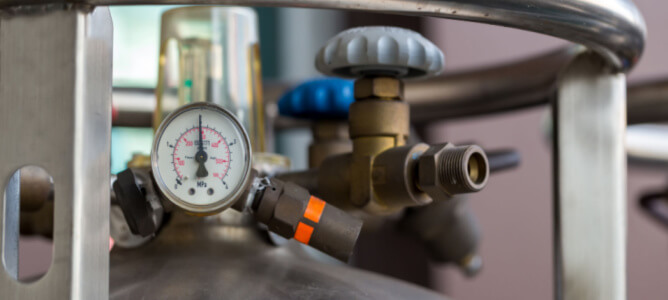
Nitrogen Sparging Equipment: An Overview
Sparging is essential to several industrial processes since it offers various benefits, including corrosion, contaminant, and energy cost reductions. In addition, the process requires high-purity compressed nitrogen to minimize oxygen concentration in storage tanks and other industrial equipment. First, however, operators must identify and implement the ideal method for obtaining nitrogen for sparging. This article gives an overview of nitrogen sparging, emphasizing the various techniques for procuring nitrogen.
What is Nitrogen Sparging?
Nitrogen sparging involves injecting nitrogen gas into a liquid phase through a diffuser. In other words, nitrogen sparging involves passing finely dispersed nitrogen gas through liquids. In addition to reducing oxygen content, nitrogen sparging can intensify biological and chemical reactions.
Metallic storage tanks for several kinds of liquid, including water, are susceptible to corrosion due to significant oxygen content. However, with nitrogen sparging, these tanks can maintain a protective layer of nitrogen and eliminate dissolved oxygen and other reactive gases from the liquid, minimizing corrosion and contamination and ultimately reducing production and operating costs in several industries.
What is the Purpose of Nitrogen Sparging Equipment?
Nitrogen sparging equipment is essential in meeting consumer and industry requirements in several applications. Generally, sparging enables the elimination of unwanted substances and undesirable chemical reactions with oxygen. In addition, operators ensure a consistent supply of inert nitrogen gas to various industrial processes by installing the ideal nitrogen sparging equipment.
This typically comprises a valve-control system, sparging elements, nitrogen source, and valves. The valve-control system ensures a consistent supply of nitrogen gas into the storage tank or industrial process by automatically adjusting the nitrogen levels to maintain a protective layer against oxidation. Hence, this system ensures the required nitrogen level during tank filling and emptying.
Sparging elements are sintered stainless steel plates or rods that play a crucial role in sparging with nitrogen. These elements purge the liquid (e.g., water) continuously to achieve minimal oxygen contents, which, in turn, minimizes corrosion and enables anaerobic activities.
Plant operators achieve corrosion- and copper oxide-free industrial processes with nitrogen sparging equipment. Moreover, copper, iron, oxygen, and other reactive element reductions can significantly lead to a corresponding minimization of energy costs. For instance, conventional power plants require auxiliary steam for deaerators. However, with nitrogen sparging equipment, the plants can operate optimally with a minimal chance of storage tank contamination.

Industries that Rely on Sparging
There are many uses for nitrogen gas sparging — from food processing, power generation, pharmaceuticals, and wastewater management, N2 manufacturing, to pH control. For example, sparging nitrogen through demineralized and deionized water during process operations in the power generation industry can significantly minimize corrosion-induced damages to boiler and feeder systems. Thus, sparging can improve the efficiency and cost-effectiveness of the entire system.
In light of the food processing industry, operators carry out gas sparging into food and beverages, sparging nitrogen and carbon dioxide into wine and juice, and blanketing drinks during filling and transportation. Sparging inhibits oxidation and replaces harsh physical or chemical preservative methods in the food processing industry.
In other industrial applications, operators can leverage sparging to achieve stable pH values in processed water, contaminant-free pharmaceutical processes, steam sparging in pipelines, and reactant gas dissolution into liquid phases for further reaction, such as fermentation, oxidation, and ozonation.
Obtaining Nitrogen for Sparging
The nitrogen source is a crucial factor that operators must consider in their sparging applications. Although 78% of atmospheric air is nitrogen gas, sparging processes require high-purity compressed nitrogen to achieve significant results. Some typical methods for obtaining nitrogen for sparging include:
- Nitrogen delivery
- Onsite nitrogen generation
Nitrogen Delivery
Operators opt for nitrogen delivery via several media, including high-pressure cylinders, microbulk, and bulk liquid tanks. While high-pressure cylinders are unsuitable for sparging due to limited storage sizes that result in process inefficiencies, microbulk tanks can contain sufficient nitrogen for sparging. However, microbulk tanks can cause significant losses to operators through nitrogen evaporation.
Bulk liquid tanks, on the other hand, delivered by trucks, require large insulated vessels for storage. Operators mount these insulated vessels on a concrete slab and protect them with a fence. This additional infrastructure increases the entire cost of the sparging process. Although nitrogen gas delivery for sparging creates a perception of endless nitrogen gas supply and requires minimal maintenance, this method is susceptible to price and contract inconsistencies.
Onsite Nitrogen Generation
Generating nitrogen gas onsite involves the production of up to 99.999% pure nitrogen from a compressed air supply. As a result, operators can opt for onsite nitrogen generators to generate nitrogen gas on demand for sparging operations at a lower cost of about $0.15/ccf (hundred cubic feet) in contrast to nitrogen delivery cost of at least $0.70/ccf.
It is noteworthy that onsite nitrogen generators are temperature-sensitive. Operators account for this factor when considering onsite nitrogen generators since they require weather-protected areas. However, onsite generators are a better option than nitrogen delivery due to low costs, high efficiency, and a consistent nitrogen supply.
Visit NiGen for Industrial Grade Nitrogen Generators
NiGen is dedicated to designing, manufacturing, and installing best-in-class nitrogen generation systems that meet consumer and industry standards. We offer expertise to assist our customers in selecting and setting up the ideal nitrogen supply scheme for their sparging applications. We also distribute air dryers, booster air compressors, industrial air filtration systems, and more.
Visit us today for all your onsite nitrogen generation needs.
